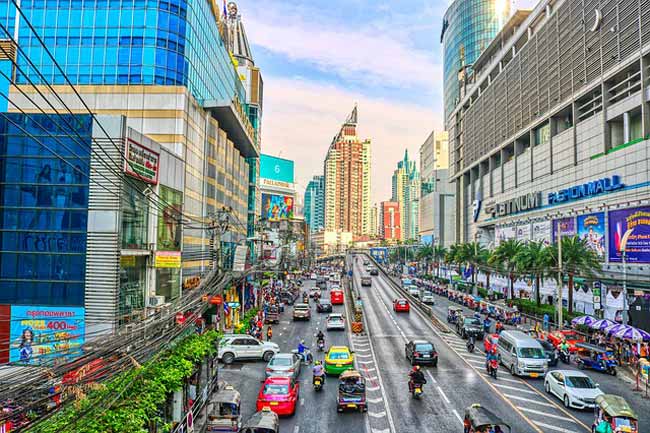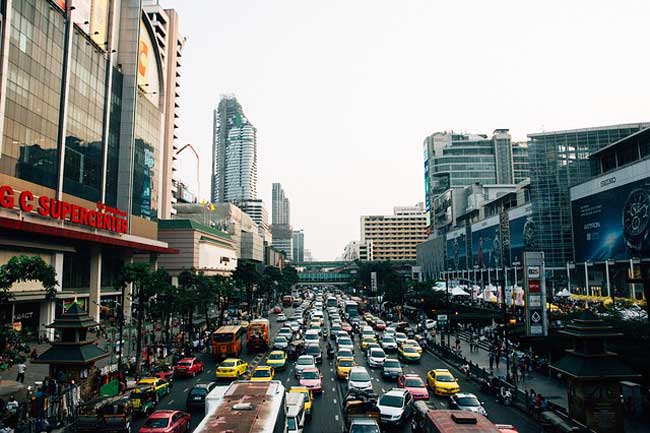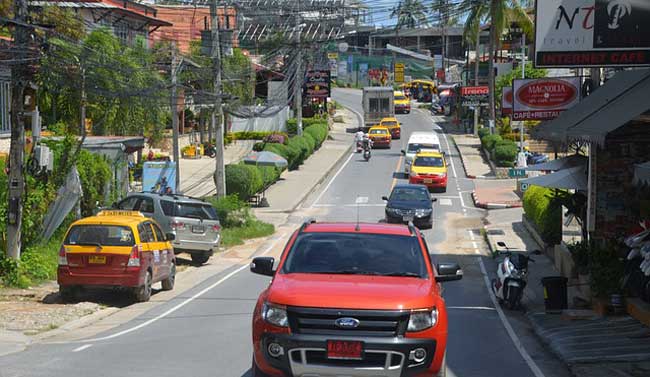If you're planning on driving on your holiday in Thailand, then you might be a little apprehensive – and rightly so.
If you're from a country where driving laws are well enforced, then you may be a little surprised at how often motorists ignore the road rules in Thailand.
I don't drive daily in Thailand, but I've had my fair share of experience on in-country holidays.
Of course, every country has its fair share of bad drivers, and it's not like I don't find myself swearing under my breath back home. The problem in Thailand is that for many years the test to obtain your driving license was so easy that it meant many inexperienced drivers took to the roads without ever really understanding the laws.
The actual test itself didn't involve any real driving on the roads, but rather simulated roads on derelict land – think driving in and out of cones. The test standards have got better in recent years, but driving standards remain poor.
If you drive cautiously and defensively, you will be fine. Just use your mirrors lots and always keep a good distance between yourself and the car in front; that way you will be able to anticipate any silly maneuvers such as turning off without signaling.
Anyway, before I give you some more detailed safety tips, let's have a look at what documents you need.

Pulling out of side turnings onto main roads can be difficult. Be bold!
Required Documents to Drive in Thailand
Thailand offers a diverse range of transportation options and you can pretty much always find a way to get around, and inexpensively, too.
However, many visitors find themselves drawn to the allure of riding a motorcycle to venture off the beaten path and embrace the freedom of independent transport. Similarly, driving a car also presents an attractive option, especially for families or those seeking a more comfortable and cooler mode of transportation.
Whether you opt for two wheels or four, being aware of the legal obligations for the correct documentation is crucial to avoid any complications and ensure a hassle-free holiday.
1. Valid Driver's License
It seems obvious, but you'd be surprised how many people forget to bring their license, or even try to hire a motorbike without one. Indeed, one hears stories back home about Thailand being a tad “wild west” and that rules here are easy to skirt around. This certainly isn't the case when it comes to hiring a bike or car.
I remember picking up my hire car about 5 years ago. I still had a paper driver's license, simply because I hadn't been back to the UK to apply for the newer photo ID version. Because the clerk hadn't seen one before, I was nearly refused hire and had to make a polite song and dance about it being a legitimate license.
In short: You must have a valid driver's license issued by your home country. The license should be in English or accompanied by an official translation.
2. International Driving Permit (IDP)
Few people realize you need an International Driving Permit (IDP). This is because you are rarely asked, especially when hiring a bike or a car – they usually just ask for a license.
I've been stopped at a police blockade on a few occasions and never been asked then either. But it is actually a requirement.
An International Driving Permit (IDP) is a document regulated by the United Nations. Many countries require an IDP for renting a motor vehicle, and it can also be incredibly helpful in situations where identification or assistance is needed.
With your IDP, you have a valid form of identification in over 150 countries worldwide, as it contains your name, photo, and driver information in multiple languages. This ensures that local officials and authorities in the countries you visit can easily understand and verify your credentials.
When renting a vehicle, or when stopped by the police, you should present both your license an IDP.
3. Passport
Contrary to popular belief, it is not a legal requirement for tourists to carry their passport with them at all times. However, you are required to have some form of identification with you, such as a photocopy of your passport's main page or a digital copy on your smartphone, or your driver's license.
However, it is important to note that if you are driving a vehicle in Thailand, you must carry your original passport or a certified copy of it while on the road, as it serves as proof of identification and verifies your legal status in the country.
In reality, if you have your license and IDP, a color printed copy of your passport, or digital scan on your phone, will be just fine. I personally do not recommend carrying your original passport around with you.
7 Tips for Driving on Holiday in Thailand
1. Driving on the Left
If you're from the United Kingdom, New Zealand, South Africa, or Singapore, driving on the left-hand side is familiar. However, if you're from the USA, Germany, Switzerland, or China, it can be challenging.
It's crucial to remember this rule, especially when tired or jet-lagged. Adapting to left turns at stoplights and yielding to oncoming traffic for wide right turns is necessary.
I recall my experience driving state to state in America, struggling to adjust on the freeways—it was quite a nightmare.
2. Intersection Etiquette
Hardly proper etiquette, but it's important to take note of the following:
Not all intersections, especially smaller ones, have stop signs.
Even if a stop sign is present, many drivers will try to dash across if they perceive no immediate danger, sometimes even when there is approaching traffic.
Be cautious of motorcyclists unexpectedly emerging at intersections, disregarding their right of way. This is a common occurrence in Bangkok.
While waiting at an intersection, you may witness motorcyclists edging forward, rolling through stop signs, and making illegal U-turns. They tend to refrain from such actions if they spot a policeman in a nearby police box.
3. Pedestrian Crossings
In the UK, we have zebra crossings where motorists are required to stop and let pedestrians cross. Thailand has attempted to implement a similar concept, but many drivers do not adhere to it.
Pedestrian crossings exist at intersections, where pedestrians are signaled to walk when the lights are red.
However, at non-intersection pedestrian crossings, drivers generally do not stop, even when pedestrians are waiting.
The problem arises when you suddenly stop to allow a pedestrian to cross. The car behind you may not anticipate this since it is not a common practice, increasing the risk of a rear-end collision.
My advice is to adopt the local approach:
- When the traffic light is green, slow down and check for crossing pedestrians. If none are present, continue driving.
- When the traffic light is red, follow the same procedure and remain vigilant for pedestrians.
It may seem unconventional, but by following these guidelines, you reduce the likelihood of being the sole car obstructing the road.
4. Stoplights
Motorcyclists often gather at the front of traffic at stoplights. Some cars leave a gap between themselves and the white line to accommodate them.
If you find yourself surrounded by motorcycles when stopped, don't panic. Many of them will position themselves right in front of your car, even touching it.
When the light turns green, simply wait for the motorcyclists to accelerate, as they do so rapidly, and then proceed with your own movement.

Oftentimes you won't have to worry about driving in Bangkok, because the traffic doesn't move!
5. Lane Switching
If you have been taught to drive properly, you likely check your rearview mirror, wing mirror, and look over your shoulder before changing lanes.
In Thailand, drivers are generally not as diligent when it comes to lane changes.
You will undoubtedly come across individuals who appear to have neglected their mirrors entirely. Many drivers only take a quick glance before switching lanes. Therefore, it is important to remain attentive to the vehicle in front of you, whether it is directly ahead or in the adjacent lanes.
6. Parking
The general rule appears to be that if there is enough space, you can park there, which may lead to some incredibly poor parking examples.
However, be aware of signs indicating “No Parking on Even/Odd Days” or “No Parking from 7-9am.”
Furthermore, curbs with red and white stripes are off-limits for parking.
There are also specific parking areas designated for taxis, motorbike taxis and tuk tuks, so if you're in one of the cities or on one of the islands you need to be aware of that.
Don't panic if you come across cars parked in driving lanes along certain streets. Wider streets with three lanes often shrink to two as people utilize them for parking. This is especially prevalent in Bangkok.

Islands have less traffic but the roads a tad more wild west!
7. Headlight Flashing
In the United Kingdom, it is customary to flash the headlights to indicate that we are allowing another driver to proceed first. As the driver being let through, we often give a flash of the headlights as a way to express gratitude.
However, in Thailand, if someone is flashing their headlights at you, it generally indicates a signal for you to clear the way. This practice also applies on motorways in the UK when someone wants you to change lanes.
——
I'm sure you'll be just fine, but do make sure you have good travel insurance.
+ See My Insurance Recommendations Here
Tips to Start Planning Your Trip:
Book Your Accommodation
Book your accommodation for the Mae Hong Son loop at a discounted rate on Agoda
Don’t Forget Travel Insurance
You will need insurance that covers a road trip on a motorbike. I use SafetyWing.
Learn Some Thai
If you plan on sticking around in Thailand for a while, learning Thai is a huge benefit. Get a free account with Thaipod101 here.